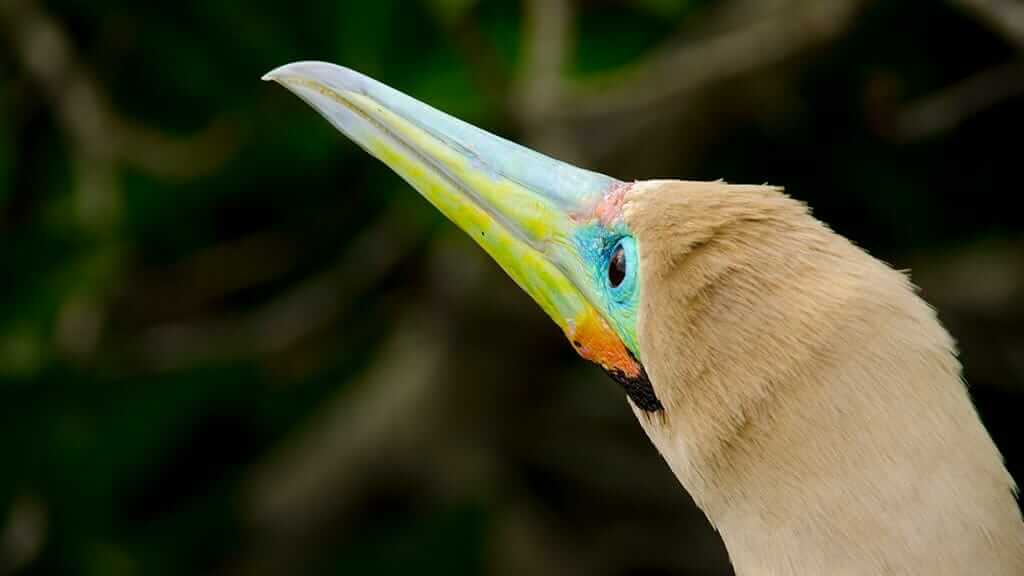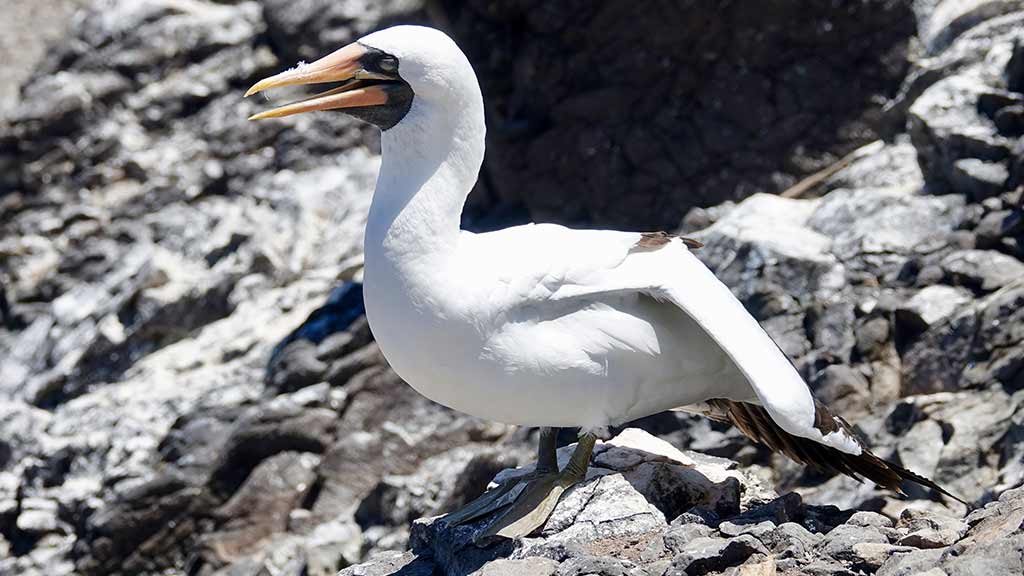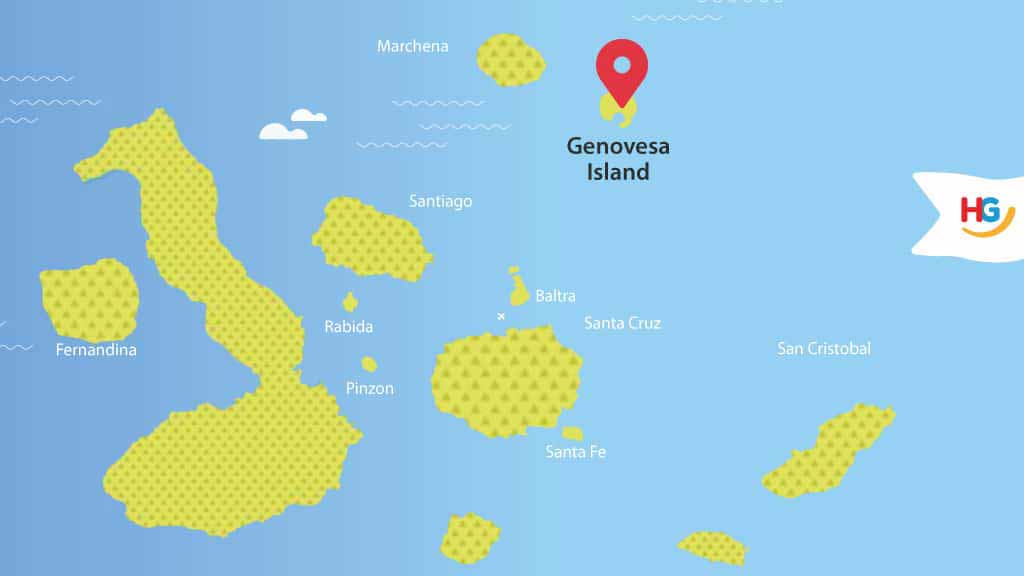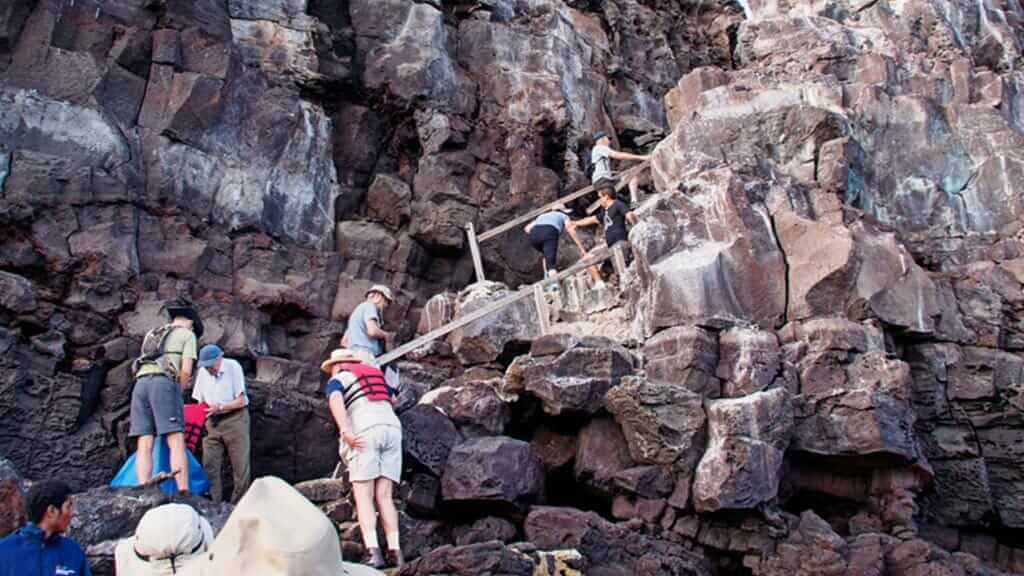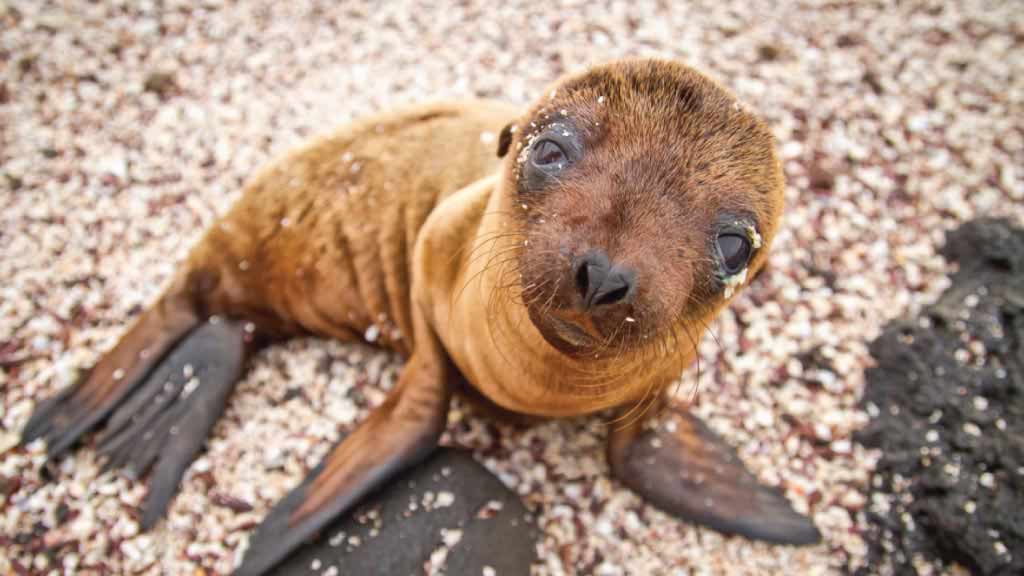GENOVESA ISLAND (ISLA GENOVESA)
Genovesa Island is one of the most popular places to visit in the Galapagos Archipelago. Genovesa is known as the Bird Island, and for good reason! Here visitors find a great diversity of seabird species, including the elusive red-footed booby. Land birds like the Galapagos Short-eared Owl and Genovesa Finches are also special sightings. Even if you are not especially into birdwatching, the sheer volume of birds at Genovesa Island is hard not to appreciate - at times they seem to cover the entire sky. Genovea's underwater action is also right up there. Darwin Bay Genovesa is one of the top Galapagos snorkeling sites, where visitors can share the sea with all kinds of colorful fish and sharks. Not all cruise ships go up north to visit Genovesa Island, but in our opinion, it's well worth going the extra mile. Genovesa Islands is a Galapagos highlight not to be missed!
Keep reading for everything you need to know to plan your visit to Genovesa Island at Galapagos. What wildlife to spot on Genovesa? Which activities and visitor sites await? Plus lots of fun facts about the history and geology of Genovesa Island.
SECURE YOUR GALAPAGOS TRAVEL
Get a FREE personalised quote todayGenovesa Island Animal Highlights:
• Genovesa Island is a nirvana for Galapagos bird watching – not only can you see a great diversity of bird species, but also a dizzying volume of birds flying all around you.
• Genovesa is home to the largest colony of red-footed boobies on the planet, with a population of over 140,000 breeding pairs. It's also the best spot to see these colorful birds on the archipelago.
• Other Genovesa bird species include: nesting Frigate birds, lava gulls, lava herons, and the pretty Swallow-tailed gull – the only nocturnal gull in the world.
• Observe short-eared owls hunting storm petrels as they emerge from their burrows.
• Enjoy amazing snorkeling in the calm waters of Darwin Bay, with Manta Rays, fish galore, and possible hammerhead shark sightings.
• Darwin Bay is also a pleasant spot for kayaking (check in advance whether your Galapagos yacht carries kayaks onboard).
About Genovesa Island
English Name: Tower.
Ecuadorian Name: Genovesa.
Total Area: 5.4 sq miles.
Human Population: zero (uninhabited)
Genovesa certainly lives up to its reputation as the Bird Island of the Galapagos - both in species diversity and population size! The cold nutrient-rich waters around Genovesa Island provide the perfect conditions for sea birds to thrive. Here, visitors can get up close to the nesting sites of large bird colonies. This is ideal for observing unique bird behavior in the nest as well as diving for food. So birdwatchers, do try to include Genovesa Island into your itinerary – you definitely won’t be disappointed!
Due to its remote location far to the north of the archipelago, few land species ever arrived in Genovesa. But the sea birds and underwater marine life more than makeup for it.
Genovesa Island Geology:
The island of Genovesa is the remains of an old shield volcano. A long and flat crater was built up slowly by successive lava flows until one side of the caldera collapsed letting sea water in.
So what we see today is a pretty bay protected by horse-shoe-shaped crater walls of the submerged volcano. The calm waters of the protected bay make for fabulous snorkeling or kayaking, while cliff walls provide nesting sites for seabirds, and two visitor trails walk you through huge colonies of red-footed boobies and frigates.
GET FREE ADVICE
From a Galapagos destination expert todayGenovesa Island Habitat:
Genovesa's habitat is a bit of a mixed bag. Arid scrubland with low bushes is perfect for nesting red-footed boobies and Frigates. The large barren petrified lava flows are more suited to owl and petrel nesting. While steep cliffs are ideal for other seabird species.
Genovesa Galapagos History:
The landing sites on Genovesa Island are named in honor of several famous people. The name of the island itself comes from the Italian city of Genoa – the birthplace of the famous explorer Christopher Columbus. Meanwhile, the two landing sites derive their names from Prince Philip (the British royal who visited the island in 1965 and 1981), and Charles Darwin (who of course needs no introduction).
Fun Genovesa Island Fact:
The short-eared owl on Genovesa island is an incredibly skilled stealth predator. They use highly effective camouflage against the dark lava rocks, waiting for the right moment to strike. Swooping in silently their prey rarely knows what hit them. On Genovesa island they have also developed a unique technique to hunt storm petrels. Petrels are faster and more agile in flight than owls. So the cunning Short-eared owl has to adapt to stalk their prey. Petrels nest in protective tunnels in the lava. So the observant owl stakes them out, watching and learning where the petrels enter and leave their tunnels. The clever owl then waits patiently by the entrance and catches the petrels unawares as they fly out.
Where Is Genovesa Island?
How to visit Genovesa Galapagos?
This island is far away to the north of the archipelago, too far for a Genovesa island day trip. It is therefore accessible only aboard Galapagos Cruise Itineraries that operate a loop of the northern islands. Be sure to check your cruise itinerary carefully during trip planning if you wish to visit Genovesa.
Contact us for a FREE TOUR QUOTE, or for more information to plan your Galapagos vacation.
Genovesa Island Galapagos Visitor Sites
Visitors to Genovesa Island can enjoy a wonderful variety of activities. There are two different visitor sites with trekking trails. Plus you'll usually have free time for snorkeling or kayaking in the calm bay waters of the collapsed crater. Read on for more information about each Genovesa Island visitor site.
1. Prince Phillip’s Steps (El Barranco)
Landing Type: Dry, sometimes with choppy water.
Trail length: Approx 2 hour hike (2km).
Terrain: The trail starts with steep, challenging, rocky steps, which level out to a flat plateau with a sandy/rocky trail.
After landing at the dock, you are immediately faced with the toughest part of Prince Phillip’s Steps – the steep climb. Steps ascend 8 meters, with a handrail for balance – just take it slow, or ask your guide for assistance if this part worries you. At the top of the steps, a plateau opens out, straight into colonies of Red-footed boobies and Nazca boobies. Genovesa Island is home to the largest colony of Red-footed boobies on the planet and is one of the few sites in Galapagos where you can find them. It’s easy to tell the nests apart – Nazca boobies nest on the ground, while their Red footed cousins build nests at eye-level in the Palo Santo trees or shrubs. Also, keep an eye out for mockingbirds and finches along this trail.
Further up we enter a different habitat of dark petrified lava flows – a harsh landscape, but home to some new bird species. This is the best spot in the Galapagos Islands to spot Short-eared Owls, wonderfully camouflaged against the brown/black rocks. The owls hunt Storm Petrels by keen observation and stealth, waiting to catch the petrels unaware as they fly out from their burrows.
Impressive panoramic views can be enjoyed from this high point of Genovesa Island, where Wedge-rumped Storm Petrels swarm in their hundreds, together with Galapagos swallows and Galapagos doves.
2. Darwin Bay (Bahia Darwin)
Landing Type: Wet.
Trail length: 1-2 hour hike (approx 1.5 km).
Terrain: An easy trail along the beach.
Genovesa Island’s second visitor site is Darwin Bay. A beautiful white coral sand beach, home to sea lions, marine iguanas, sally lightfoot crabs, and great frigate birds.
After a wet landing, a short trail heads inland to a tidal pool, for our first view of beautiful Swallow-tailed gulls. These elegant and beautiful seabirds nest in lava cracks. They have developed night vision (unique for gull species) to be able to hunt for squid and small fish nocturnally, with reduced risk of predation. Endemic species of Lava Gull and Lava Heron are also common here, as are playful sea lions swimming in the pools or shallows. Another curiosity of Genovesa island to look out for is the smallest marine iguana in Galapagos, the only reptile on the island.
The trail continues through Palo Santo and Opuntia forest – nesting sites for Great Frigatebirds and Red-footed Boobies. Frigate mating season begins in March, with males aiming to attract a mate to their nest by puffing out their red, balloon-like throat pouches. This is a very impressive spectacle to behold and a must-see at Galapagos.
At the end of the trail, enjoy the picturesque cliff-top view. Keep your eyes on the skies here for the lovely red-billed tropic bird, flying with graceful tail streamers.
At Darwin Bay visitors can usually also enjoy some free time to relax on the beach, snorkel in the calm, clear waters, or kayak. Darwin Bay offers some of the best Galapagos snorkeling on the islands. Here you can share the bay with sea lions, green sea turtles, sharks, Manta rays, and schools of colorful fish such as surgeon fish, butterfly hogfish, unicorn fish, king angelfish & parrot fish. But the real bucket list highlight is the opportunity to cross paths with Scalloped Hammerhead sharks that sometimes frequent this tranquil bay.
The #1 Trusted
Galapagos Travel Agency
Note: All wildlife sightings are by their very nature unpredictable, and activities may be subject to change by your guide or the National Park Authority.
In conclusion, Genovesa Island should definitely be a contender on your Galapagos destination list. Genovesa has a number of special visitor highlights that you will not find on other islands - this is especially true for bird lovers. Genovesa Island also boasts one of the best Galapagos snorkel sites, with a rare chance to swim with hammerheads. Probably the top Genovesa pick though is the huge colony of red-footed boobies - the largest such colony on the planet. All things considered, Genovesa is a highly recommended Galapagos island to visit.



